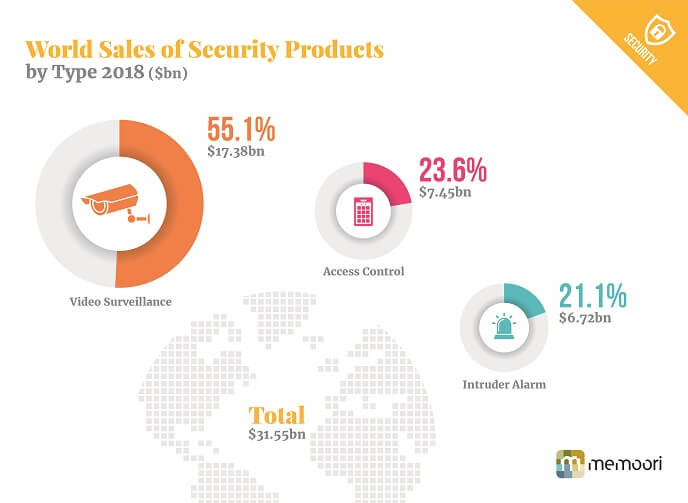Memoori’s 2018 annual
report on the physical security business shows that the total value of world production of physical security products at factory gate prices in 2018 was US$31.55 billion, an increase of 7.5 percent on 2017. This is an increase of almost 1 percent over the compound annual growth rate of 6.87 percent over the last four years. Over the last 10 years the market has grown by a compound annual growth rate of 5.92 percent, however different rates of growth apply in each of the three businesses. We forecast the market to reach $51.38 billion in 2023 at a CAGR of 10.25 percent over the next five years.
 Allan McHale, Director, Memoori
Allan McHale, Director, Memoori
In 2018 video surveillance products at $17.57 billion had a share of 55.6 percent, access control at $7.45 billion, a 23.6 percent share, and intruder alarms and perimeter protection at $6.72 billion had a 21 percent share.
Video surveillance had the highest rate of growth at 9.9 percent, an increase of 4.4 percent over 2017, which was not a particularly good year for non-Chinese manufacturers, mainly as a result of “the race to the bottom.” This brings it back into line with the average growth over the previous five years. We expect the market to grow at a CAGR of 13.2 percent over the five-year period to 2023. Much of this growth will be attributed to a rapid rise in the sale of AI video analytics which could reach $2.3 billion by 2023, provided that it lives up to its promise. The underline rate of growth excluding video analytics will be around 8.5 percent, but this will require volume growth to deliver a CAGR of well over 10 percent as a result of component prices falling but far less aggressive pricing from Chinese manufacturers.

Access control was expected to deliver a slightly higher performance than 8 percent as it further penetrated the IP network business, advanced further into biometric, identity management, wireless locking systems and ACaaS. This was expected to be the third consecutive year that it has turned out the highest rate of growth of the three businesses. However there is some evidence that price pressures are starting to bite and this has reduced the forecast growth when measured by value. There appears to be reluctance by manufacturers to support open standards in order to protect their heritage business. This could damage their long-term future and open the way for Chinese manufactures to take up the initiative and make a strong push into the business they have recently targeted.
The intruder system business, the father of the physical security business, has long since reached maturity but its increasing use of radar, thermal and multi-sensor cameras has contributed to growth edging up to 4.5 percent in 2018. In addition, advances in sensor technologies, wireless technology and the integration with video surveillance, access and outdoor lighting have all contributed to its growth.
Business strategies will need to make some fundamental changes
There are many factors that are impacting on our industry and we believe the five below will require fundamental changes to business strategies.
1. The gap between the major suppliers and the many hundreds of smaller suppliers gets wider every year, and this is rapidly increasing the minimum economic size to operate profitably in this industry. We have now reached the stage where the video surveillance business requires a strategy that either focuses on volume through the SMB market or brand through the enterprise business. We believe that no more than five companies by 2023 will thrive by operating in both at the same time.
In the video surveillance business two Chinese manufacturers have built up volume, initially through targeting the SMB business and the gap between them today and the next tier of western companies is so wide that it looks highly improbable that it can be reversed and certainly not by western companies competing solely on price. Two Chinese companies have adopted the strategy of disrupting the industry by undercutting the profit margin of their competitors, whilst at the same time expanding markets and rapidly growing market share. This is crucial to our industry at a time when volume is becoming a critical factor and commoditization of video cameras takes hold.
Some leading western manufacturers, whilst having to trim their margins, have improved their financial performance this year by continuing to invest in delivering better performing products more resistant to cyber attacks which has grown their share. Building brand has shown that it has a very important role to play but in the present circumstances, it is not sufficient to change the dominance of the two Chinese manufacturers.
Merger and acquisition between the leading western manufacturers is seen as a possible solution to match their size, but at best we believe it could only slow down further widening of the gap. Strong brands with end-to-end solutions possibly focused on a number of vertical markets and having strong alliances with companies in other BAS services is the only other option for hardware suppliers to ensure a profitable future.
2. The region that has the highest growth and the largest share of the physical security market is China and Asia. This region has the lowest penetration of physical security equipment when measured by sales/capita and yet takes over 28 percent of the world’s market today but more like 40 percent of the video surveillance business. Therefore it should provide the best opportunity for future growth for western manufacturers. These facts show that to be in the top twenty suppliers of the world in 2023, you will need to have a significant share of this market.
3. It is ironic that physical security protection, which provides for the safety and security of people and assets in buildings and public places, is perceived as having the highest level of risk of cyber crimes. This must be the biggest single threat to our industry particularly video surveillance, which is the weakest link. Those suppliers that can prove a high level of security against cyber crimes meet the most important buying criteria today in the enterprise business. Those that are selling vulnerable products will at best find their market share decline and probably face heavy financial damages that could ruin their business. Physical security will therefore be one of the big spenders on installing cyber security systems particularly in smart buildings.
4. Software services in all its guises has achieved the highest rate of growth of all components in the physical security business achieving a growth of almost double that of hardware sales for the last five years, but it still accounts for no more than 12 percent of the business. It will rapidly increase its share and continue to benefit from higher rates of growth for many years. Much of this will come from manipulating the vast quantities of information that will be generated from physical security sensors particularly video cameras. Memoori recently published a report on AI video analytics which showed that the technical market potential for applying AI video analytics in existing installations could be around $65 billion and we assume it could take up to 30 years for this to be exhausted. To this we have added the cost of applying AI video analytics to new installations to arrive at the total technical market potential.
In 2017 the world market for video surveillance products was $15.87 billion and the estimated revenue from AI video analytics was $115 million. This would mean that AI video analytics accounted for only a miniscule proportion of the total video surveillance market that year. We estimate that by 2022 it would account for approximately 13 percent, provided that all the routes to market are fully developed and demand is not restricted by poor performance of AI software
.
5. Integration and IT convergence has for almost 10 years impacted all three branches of the industry and in particular video surveillance, but it’s only in the last thee years through IP networks and ONVIF that integration across all sectors has delivered more elegant and cost-effective solutions. However integration has now advanced to IoT and the Building Internet of Things (BIoT) that’s joining all the BAS services in the building eventually on one two-way network, for this will create an open, comprehensive holistic solutions that will fly on autopilot and not need human intervention to control them. Today we can deliver advanced integrated security systems designed to provide a view of all relevant data points, enabling security personnel to quickly scan and mentally understand highly involved, intricate and sophisticated building intelligence. As identified in 4, companies are now experimenting with Big Data to refine and speed up the process.
This will require strategic alliances to be formed between companies across all the BAS Services and will have a major impact on the routes to market. Now is the time to get involved.
This has been taken from the tenth edition of Memoori’s Annual Report “The Physical Security Business 2018 – 2023.”